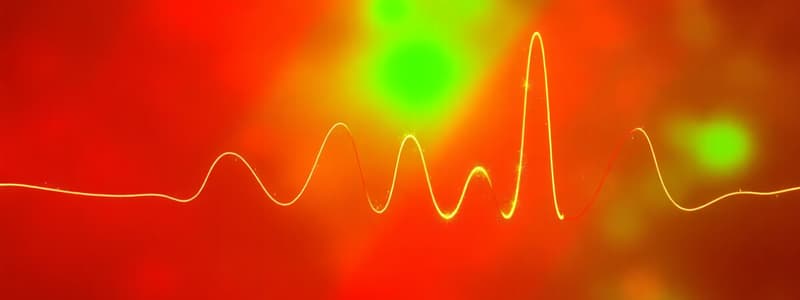Podcast
Questions and Answers
Barium salts produce a blue color in a flame test.
Barium salts produce a blue color in a flame test.
False (B)
Heisenberg’s Uncertainty principle states that the position and velocity of an electron can be known simultaneously.
Heisenberg’s Uncertainty principle states that the position and velocity of an electron can be known simultaneously.
False (B)
Millikan’s ‘oil drop’ experiments were aimed at measuring the charge on a proton.
Millikan’s ‘oil drop’ experiments were aimed at measuring the charge on a proton.
False (B)
The atomic orbital of silicon has a total of 8 occupied orbitals in its ground state.
The atomic orbital of silicon has a total of 8 occupied orbitals in its ground state.
Neils Bohr is known for his work on energy levels in the hydrogen atom.
Neils Bohr is known for his work on energy levels in the hydrogen atom.
Niels Bohr discovered that the fixed paths for electrons in an atom are called orbits.
Niels Bohr discovered that the fixed paths for electrons in an atom are called orbits.
The emission spectrum of an element can be the same as the emission spectrum of another element.
The emission spectrum of an element can be the same as the emission spectrum of another element.
Lithium salts produce a crimson flame when burned in a Bunsen burner.
Lithium salts produce a crimson flame when burned in a Bunsen burner.
A spectroscope can measure the wavelengths of light in a spectrum.
A spectroscope can measure the wavelengths of light in a spectrum.
Electrons in their ground state have the highest possible energy.
Electrons in their ground state have the highest possible energy.
Bohr theorized that energy levels in an atom are represented by the letter 'm'.
Bohr theorized that energy levels in an atom are represented by the letter 'm'.
Copper salts produce a blue-green flame during a flame test.
Copper salts produce a blue-green flame during a flame test.
Bohr's model allows an electron to have a continuous range of energy levels.
Bohr's model allows an electron to have a continuous range of energy levels.
When an electron jumps to a higher energy level, it is said to be in an excited state.
When an electron jumps to a higher energy level, it is said to be in an excited state.
The energy absorbed by an atom is always greater than the energy difference between its ground and excited states.
The energy absorbed by an atom is always greater than the energy difference between its ground and excited states.
The Balmer Series of emissions lines is due to electrons falling to the n=3 energy level.
The Balmer Series of emissions lines is due to electrons falling to the n=3 energy level.
An Atomic Absorption Spectrometer can be used to analyze blood samples for heavy metals.
An Atomic Absorption Spectrometer can be used to analyze blood samples for heavy metals.
Electrons in the excited state are stable and remain in that state indefinitely.
Electrons in the excited state are stable and remain in that state indefinitely.
The spectrum of light emitted from an atom can show specific energy values, indicating quantized energy levels.
The spectrum of light emitted from an atom can show specific energy values, indicating quantized energy levels.
In Atomic Absorption Spectrometry, atoms absorb light of wavelengths that are not characteristic of them.
In Atomic Absorption Spectrometry, atoms absorb light of wavelengths that are not characteristic of them.
Planck's constant is represented by the letter 'p' in the equation E2 – E1 = hf.
Planck's constant is represented by the letter 'p' in the equation E2 – E1 = hf.
The amount of light absorbed is inversely proportional to the concentration of the element present in the sample.
The amount of light absorbed is inversely proportional to the concentration of the element present in the sample.
Every energy level includes at least one sublevel.
Every energy level includes at least one sublevel.
The 'd' orbital has a maximum capacity of 8 electrons.
The 'd' orbital has a maximum capacity of 8 electrons.
Wave-particle duality suggests that particles like electrons show both wave-like and particle-like properties.
Wave-particle duality suggests that particles like electrons show both wave-like and particle-like properties.
Bohr's theory effectively explains the emission spectra of all elements in the periodic table.
Bohr's theory effectively explains the emission spectra of all elements in the periodic table.
An 's' orbital is said to have a dumbbell shape.
An 's' orbital is said to have a dumbbell shape.
Heisenberg's Uncertainty Principle states that the speed and position of an electron can be measured simultaneously.
Heisenberg's Uncertainty Principle states that the speed and position of an electron can be measured simultaneously.
The number of sublevels in an energy level is equal to the value of n for that level.
The number of sublevels in an energy level is equal to the value of n for that level.
Flashcards
Emission Spectrum
Emission Spectrum
A spectrum consisting of specific, narrow colored lines of light, unique to each element.
Quantized Energy Levels
Quantized Energy Levels
Electrons in an atom can only have specific, fixed amounts of energy.
Ground State
Ground State
The lowest energy level an electron in an atom can occupy.
Energy Levels (Orbits)
Energy Levels (Orbits)
Signup and view all the flashcards
Quantum of Energy
Quantum of Energy
Signup and view all the flashcards
Bohr Model
Bohr Model
Signup and view all the flashcards
Spectrometer
Spectrometer
Signup and view all the flashcards
Flame Test
Flame Test
Signup and view all the flashcards
Excited state of an atom
Excited state of an atom
Signup and view all the flashcards
Ground state of an atom
Ground state of an atom
Signup and view all the flashcards
Atomic Absorption Spectrum
Atomic Absorption Spectrum
Signup and view all the flashcards
Atomic Absorption Spectrometry (AAS)
Atomic Absorption Spectrometry (AAS)
Signup and view all the flashcards
Energy level
Energy level
Signup and view all the flashcards
Balmer series
Balmer series
Signup and view all the flashcards
Photon
Photon
Signup and view all the flashcards
Barium Flame Test Color
Barium Flame Test Color
Signup and view all the flashcards
Thomson Plum Pudding Model
Thomson Plum Pudding Model
Signup and view all the flashcards
Heisenberg Uncertainty Principle
Heisenberg Uncertainty Principle
Signup and view all the flashcards
Millikan's Oil Drop Experiments
Millikan's Oil Drop Experiments
Signup and view all the flashcards
Electron Configuration of Iron
Electron Configuration of Iron
Signup and view all the flashcards
Energy Sublevels
Energy Sublevels
Signup and view all the flashcards
Atomic Orbital
Atomic Orbital
Signup and view all the flashcards
s orbital
s orbital
Signup and view all the flashcards
p orbital
p orbital
Signup and view all the flashcards
Wave-Particle Duality
Wave-Particle Duality
Signup and view all the flashcards
Bohr's model limitations
Bohr's model limitations
Signup and view all the flashcards
Light absorption & concentration
Light absorption & concentration
Signup and view all the flashcards
Study Notes
Arrangement of Electrons in the Atom
- Bohr, a Danish scientist, explained electron arrangement in atoms.
- White light, passed through a prism, separates into a continuous spectrum (rainbow).
- Bohr used a hydrogen gas discharge tube and a prism to create an emission spectrum, consisting of narrow coloured lines.
Hydrogen Spectrum
- Emission spectra are crucial in identifying elements.
- Each element has a unique emission spectrum.
- A spectrometer measures the wavelength of spectral lines.
- A spectroscope displays but does not measure wavelengths.
Mandatory Experiment
- Flame tests identify metals.
- Using a damp wooden splint and a Bunsen burner, salts are used in flame tests.
- The colour of the flame indicates the metal present.
- Metals and their corresponding flame colours are: lithium - crimson, potassium - lilac, barium - green, strontium - red, copper - blue-green, and sodium - yellow.
The Bohr Theory
- Electrons orbit the nucleus in fixed energy levels (orbits).
- Energy levels are represented by 'n' (lowest is n=1).
- Electrons do not gain or lose energy while in a fixed energy level.
- The ground state is the lowest energy level occupied by electrons.
- Excited state occurs when electrons absorb energy and jump to higher levels.
- Energy absorbed matches the difference between the ground and excited state energy.
- Electrons return to lower levels, emitting light of specific frequencies.
- Frequency differences correlate with specific coloured lines in the spectrum.
Atomic Absorption Spectrometry (AAS)
- Atoms absorb light at specific wavelengths.
- The absorbed wavelengths match emission wavelengths.
- AAS measures the absorption spectrum, identifying elements.
- Used in various applications like water or blood sample analysis.
- The amount of absorbed light directly correlates with element concentration.
Energy Sublevels
- Each energy level (except n=1) divides into sublevels.
- Sublevels contain orbitals of similar energy.
- Each level has the same number of sublevels denoted by n.
- The number of sublevels increases with increasing energy levels (n = 1 has one sublevel, n = 2 has two, and so on).
Wave Nature of the Electron
- Electrons exhibit wave-particle duality, meaning they have wave-like properties.
- Louis de Broglie suggested that particles move as waves.
- Heisenberg's uncertainty principle states that simultaneous precise measurement of electron velocity and position is impossible.
- Bohr's theory doesn't fully account for the behaviour of complex atoms with more than one electron.
- Bohr's theory does not explain wave motion of electrons, splitting of lines, lack of specificity .
Atomic Orbitals
- Orbitals are regions in space where an electron is likely to be found.
- s orbitals are spherical, p orbitals have dumbbell shapes.
- Different sublevels (s, p, d, f) hold different numbers of electrons.
- Atomic orbitals relate to the arrangement of electrons.
Studying That Suits You
Use AI to generate personalized quizzes and flashcards to suit your learning preferences.




